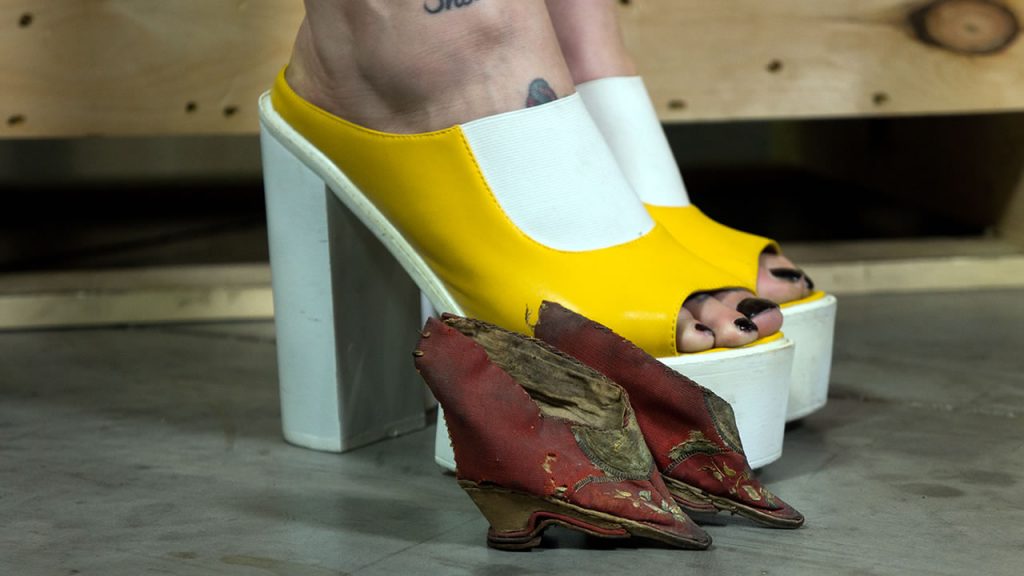Winner of the Fall 2016 StMU History Media Award for
Best Use of Scholarship
Best Article in the Category of “World History”
Best Use of Primary Sources
When I knew I couldn’t suffer another moment of pain and tears fell on my bloody bindings, my mother spoke softly into my ear, encouraging me to go one more hour, one more day, one more week, reminding me of the rewards I would have if I carried on a little longer. In this way, she taught me how to endure—not just the physical trials of footbinding or childbearing, but the more torturous pain of the heart, mind, and soul.1
More often than necessary, women are consumed with the idea of infatuation. Every culture has its own form of standards that pertain to women and what constitutes beauty. Although the world is slightly more accepting now, women used to go to extreme lengths to achieve an image that would be deemed attractive. In the Chinese culture, foot binding was that well-known beauty expectation for centuries. What started off as a celebrity fad, turned into a way of determining social status and eventually an all-around beauty expectation. 2 The objective of foot binding was for women to have the smallest foot possible, starting at very young ages. Not only was this a painful process for girls as young as five years, but it also promoted the idea that women must mutilate their bodies to become appealing to men. At some point in time, women began to just accept that this was something that was supposed to be done in order to be attractive. Often referred to as “lotus boats” or “golden lotuses,” bound feet started as a fad for the famous, and slowly made its way to becoming the social norm.3

This practice began around the tenth century with women in the entertainment business. These women were adored for their tiny arched feet and were seen by men to be much more attractive than middle class women with average feet. As these dancers were gaining an audience, the idea of “lotus feet” was becoming familiar. Not long after these performers expressed their “beauty,” foot binding became a norm for women who wanted to fit in and even for those who had a desire to find a husband.4 This painful process consisted of the breaking of young girl’s toes to form the desired triangular shape. Then the arch of the foot would be bent horizontally from the toes all the way to the heel. As if this was not painful enough, the girls were forced to walk on their feet to intensify the arch, breaking the foot even more. After all of this, the foot would be wrapped to maintain the shape of it as well as prevent any sort of deviation.5

Although this practice was around for centuries, it was only a matter of time before someone realized how inhumane and cruel it really was. Thankfully, many people began to protest against foot binding, forming “anti-foot binding organizations” to raise awareness on the inhumanity of binding women’s feet. By the 1950’s, laws were passed, allowing women to unbind their feet. Although hesitant at first, the trend slowly declined. Many women protested to unbinding their feet, due to the fact that it had been a social norm a thousand years. However, the movement against foot binding continued and eventually the last of the factories that make the tiny shoes were shut down, disabling the women from continuing the custom. Today, foot binding is no longer practiced and the only women who continue to maintain the tiny feet are those elder women who refuse to let go of the past.6
- Lisa See, Snow Flower and the Secret Fan (New York: Random House Publishers, 2005), 3-4. ↵
- Yaodong Gu et al., “Foot Loading Characteristics of Chinese Bound Feet Women: A Comparative Analysis,” PLoS ONE 10, no. 4 (April 2015): 1–9, doi:10.1371/journal.pone.0121695. ↵
- Yu-ning Li, Chinese Women Through Chinese Eyes (New York: Routledge, 2015), 125-127. ↵
- Women in the Middle Ages: An Encyclopedia, 2004, s.v. “Footbinding (Late 10th Century-early 20th Century),” by Patricia Buckley Ebrey. ↵
- Amanda Foreman, “Why Footbinding Persisted in China for a Millennium,” Smithsonian, accessed November 8, 2016, http://www.smithsonianmag.com/history/why-footbinding-persisted-china-millennium-180953971/. ↵
- “Women with Bound Feet in China,” Reshaping the Body: Clothing & Cultural Practice, accessed November 8, 2016, http://exhibits.hsl.virginia.edu/clothes/lady_bound/. ↵



189 comments
Amelia Hew
It is disturbing to know that women of that time would go as far as to break the bones of their feet and reshape them into a triangular shape just to become more appealing to men. It is seriously not worth it to go such a length to appear attractive. Thankfully this inhuman act was prohibited by the law. Imagine how painful it would be to walk let alone to run and they are able to dance in those feet? From reading this article, I really admire their pain tolerance level and determination. The author done a good job in describing what life for the women of that time is like and I enjoyed reading it.
Sharriah Martinez
I have learned about foot binding before, in high school actually. This was such a great article it allowed me to realize just how crazy people actually are. Some people and traditions are insane. The pictures were so vivid they made my stomach turn, everything about this article was good. I had also heard that people in china have smaller feet than us here in the united states but it blows my that they purposely made their feet smaller. I did not know how complicated this actually was, thank you for a great read.
Vanessa Sanchez
Wow this is an amazing story. The images are just great it shows readers how exactly it looks. Society makes people do things because of fear of rejection. Fear of being different. Even tough foot binding is no longer a thing society still in fact is continuing with the main problem of this situation. We live to expectation that society puts for us. If we don’t have that perfect skin that perfect body or even that perfect hair. We are pushed to have these living expectation and in reality its cruelty. It might depend on the situation but the main problem is still going up to day and hopefully one day that might end as well.
Aracely Ortiz Soriano
I think it’s so interesting to see other culture’s crazy standards of beauty such as foot-binding, and even going as far as thinking that feet deformity is deemed attractive. It is sad to see that women and girls as young as five years old had to conform to this standard in order to be deemed “pretty”. I’m glad that laws were formed against this practice and women no longer are pressured into it.
Samantha Ruvalcaba
It’s unnerving knowing that practices like these took place for so long, and some that are even worse continue today. I enjoyed how your article explored the appeal of the bound foot in the first place. I’ve always been curious and to how and why this was possible. I can’t imagine how painful that must’ve been for those women. I can barely handle two hours in heels, this is nothing compared to such practices.
Diego Terrazas
Pain should not be mentioned along with beauty norms. It is saddening to hear that these kinds of practices were allowed and how it was deemed attractive. Self-infliction should never be considered attractive. I cannot imagine the pain these women went through in order to satisfy beauty norm. I am glad that it was outlawed and I hope that such practices do not rise again to meet social norms.
Averie Mendez
I remember reading about this as a child and thinking how odd that “attractiveness” called for small, triangular feet. However, I never saw how grotesque their unwrapped feet are after years of binding. It’s heartbreaking how so many women were pressured into mutilating their own bodies to be deemed attractive. The agonizing pain these women endured is unimaginable. I’ll definitely remember them when I’m tempted to complain about having to wear heels.
Rosario Moreno
The amount of pain that the woman must have felt basically her whole life. I still can’t imagine a five year old girl being told she has to break her feet if she wants to be pretty. I am still in shock, but at the same time this was normal. It was apart of their culture. Very descriptive article, had me wincing while I read!
Chelsea Alvarez
Prior to reading this article, I had never heard of foot binding. Vanity and beauty norms have always been pressured onto women and it is saddening to see the effects that it can have on a society. I’m glad that women are no longer pressured into this standard and that there is now laws that are against this bizarre practice because it sounds and looks extremely painful.
Avery Mascorro
This is a sad example of vanity that goes back thousands of years. Now a days we like to conveniently wipe from our memories the struggles that women have endured. Something as natural as a foot had to be painfully physically altered from its normal state. It shows we’ve come a along way as women. We accept our natural bodies so much more than before.